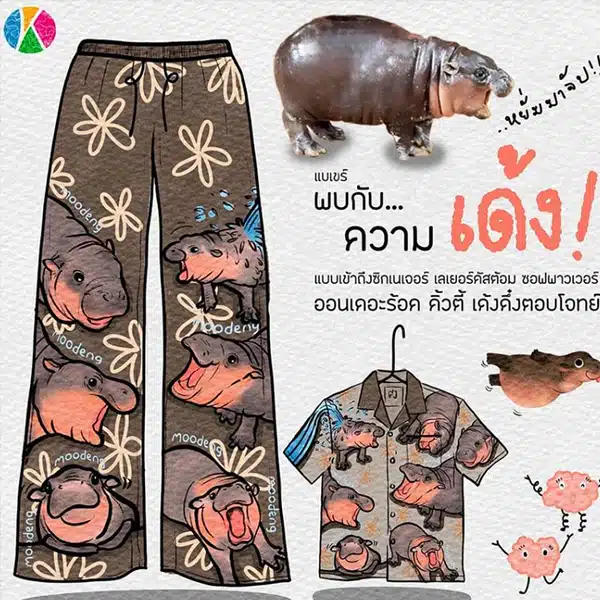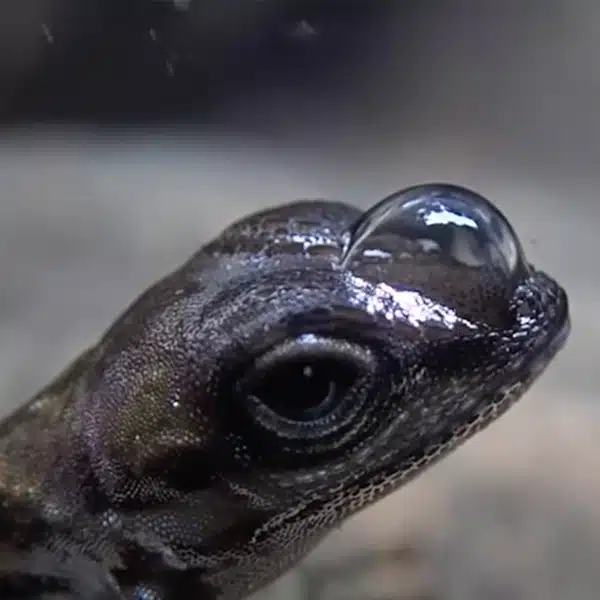
Many of us share our lives with pets, but our furry, feathered, and scaly friends experience day-to-day life differently than we do. Dogs, cats, and other animals all have their own ways of sensing the world. For example, did you know that the average cat can hear sounds at least five times farther than a human adult can? And scientists guess a dog's sense of smell is somewhere between 10,000 to 100,000 times more acute than ours.
Animals see differently than us, too. In a bid to visualize how our pets perceive the world, HomeAdvisor created digitally altered images, based on the latest scientific research. The company created a digital room within an apartment, with seven pets positioned in different areas; a dog, a cat, a goldfish, a snake, a spider, a parrot, and a chameleon. The project designer then created images based on how the specific animal would see the room, and compared it with how a human sees the same space.
A vibrant room from a human perspective is transformed into a dull, hazy expanse from the dog’s standpoint. “Your dog will take just about any style you make at home and turn it into a pastel-colored coastal living kind of affair,” Home Advisor says. “Dogs see muted combinations of the colors filtered by their two-cone eyes: blue and yellow.”
Similarly, a cat will also see a muted version of the room. “While humans have a high number of cones in our retinas, cats have lots of rods—a different type of photoreceptor cell, sensitive to low light,” explains Home Advisor. “Its color vision is somewhere between that of you and your dog, too, since it is a dichromat (has two color cones) that sees blues and yellows with a bit of green as a bonus.”
Snakes have infrared vision, meaning its vision of the room looks something like thermal imaging. And even though the spider has eight eyes, it still sees the space as a gray blur. It uses its legs to feel its way around.
Lee McCullagh of HomeAdvisor reveals that the project began after discovering that thousands of curious people had Googled “what pets see.” So, the team set about trying to answer the question. They worked with a research team to learn about how each species sees the world. “Whilst we were armed with the latest scientific findings, no one has ever viewed the world from an animal’s point of view,” admits McCullagh. “So, sometimes the garish colors made us second-guess whether an animal really did view the world in such a way, but after rereading all the findings, we were confident with the results.”
Perhaps the most bizarre perspective from the series is that of the chameleon. Not only does it absorb and mimic color, but its eyes operate independently, allowing it to see multiple views at once. McCullagh says, “The hardest to portray was the chameleon, as visualizing a 342-degree view whilst taking into consideration the ultraviolet spectrum was tough to explain to the designer, but the final result highlights just how amazing their field of vision is.”
Check out how each animal sees below and find out more about the project here.
Ever wonder how animals see the world? HomeAdvisor created a series of digitally rendered images that reveal how seven different species see the same space.

Dogs see very limited colors (mainly blue and yellow) because of their two-cone eyes.

Cats also have a muted view of the room.

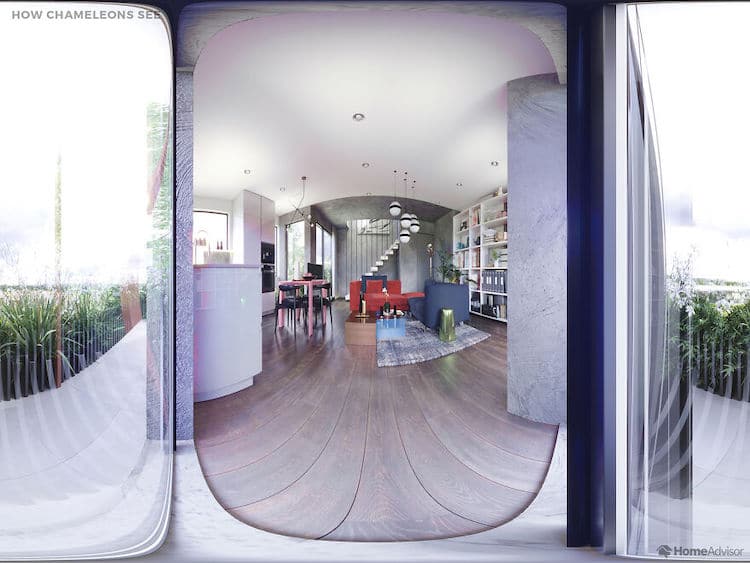
How Chameleons See
Scroll down to see the room from a goldfish's, snake's, spider's, parrot's, chameleon's perspective.

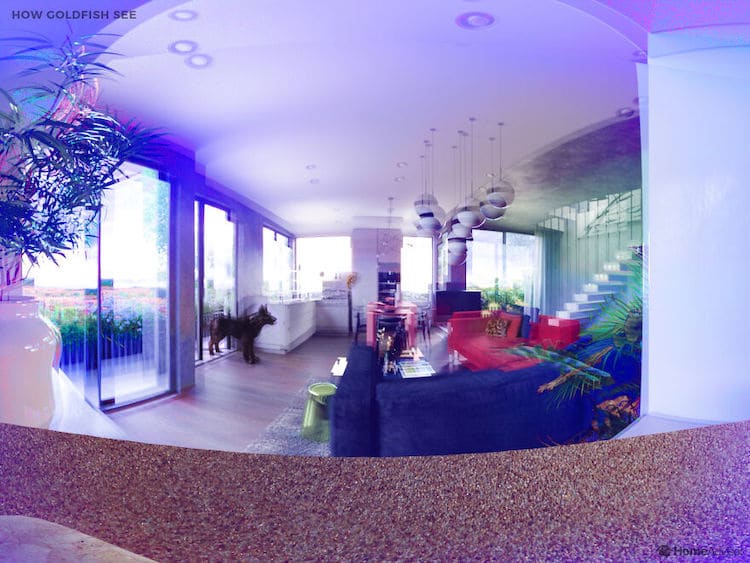
“If your goldfish turns its nose up at your new suite, it’s because she can see more colors than you. Her ability to see ultraviolet light helps her see in the water, but may also reveal where your dog has tried to mark its territory on the sofa. Appropriately enough, a goldfish also enjoys a fisheye lens effect. Its round corneas gather light from an almost 360-degree canvas, and are almost the same density as water, compensating for the warping effects of light in water.”

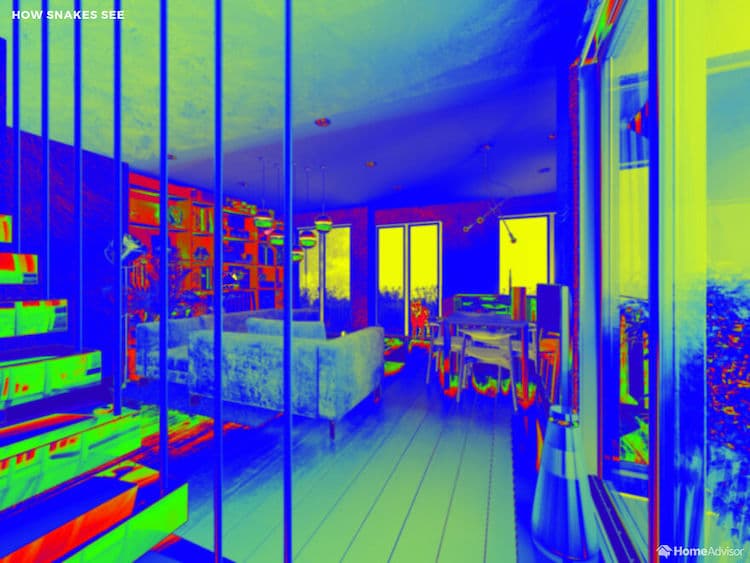
“If your only pet is a snake, you needn’t worry about the visual design of your interiors. Most snakes have very poor vision in daylight, although a good serving of rods means their nighttime vision isn’t too shabby. The bonus for some snake species is infrared vision. Your snake may merge heat-detection data from its pit organs (thin membranes between the eyes and nostrils) with visual data to create an image that looks something like thermal imaging.”

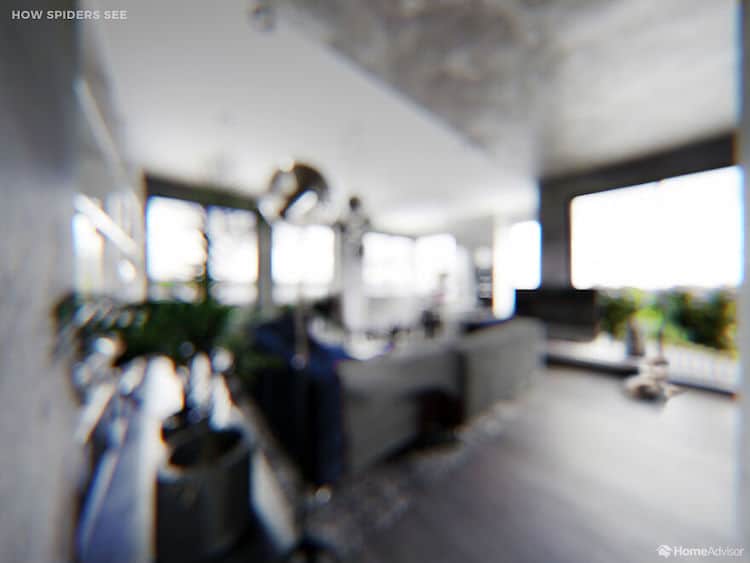
“Most spiders have eight rather feeble eyes and rely more on their hairy legs to feel their way around. However, researchers have recently noted the color-sensing structures of opsins (a type of protein) might make them sensitive to color, and might be used to find mates. So if you notice your tarantula getting frisky with a bright blue ashtray, you know that science is on to something.”

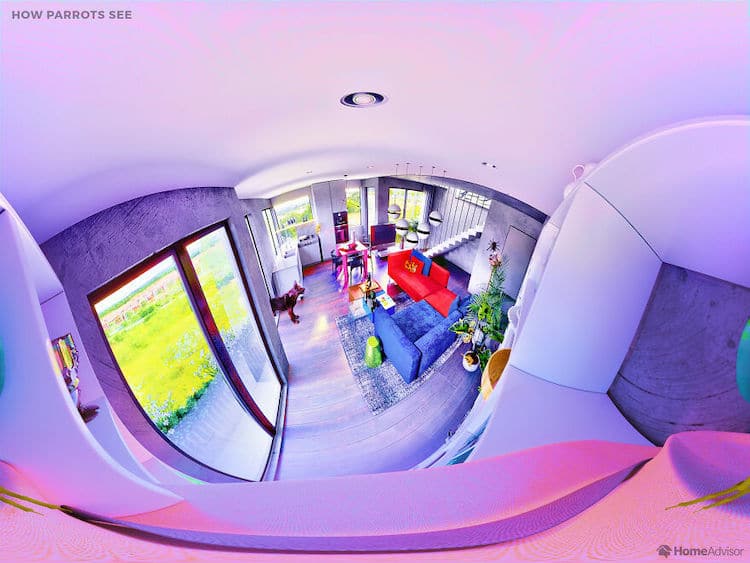
“Birds rely heavily on a highly effective visual system, and your parrot can see UV, blue, green, and red color ranges. In fact, the ‘violet’ color in this picture has been used to double for ultraviolet, which is actually colorless and invisible to humans. Polly can also adjust her focus super-quickly and has near 300-degree coverage but monocular vision, meaning one eye focuses on one thing while the other wanders. She can also contract her pupils at will, for example, if she doesn’t dig your new lampshade.”

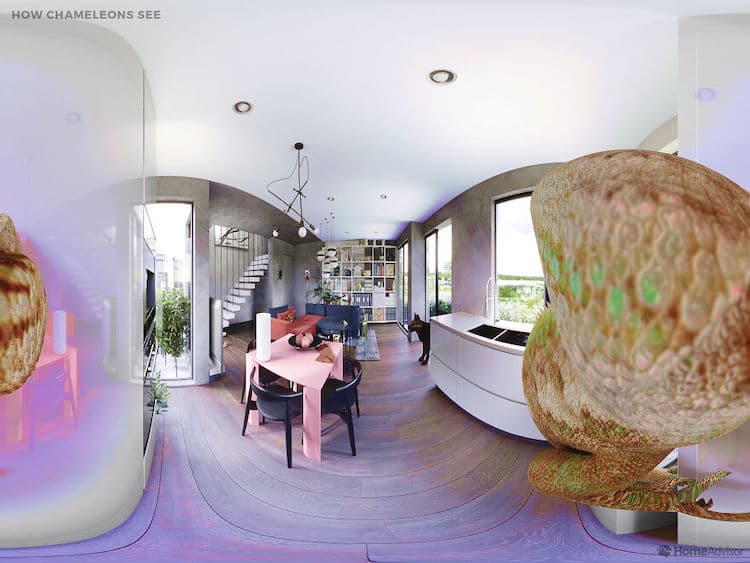
“Who cares more about your choice of living room palette than your pet chameleon? Not only does he absorb, transform, and re-emit color (changing to regulate temperature and communicate), his eyes are almost all ‘cone’ and no ‘rod,’ so he sees lots of colors (including the ultraviolet spectrum) but little contrast. Your chameleon’s eyes operate independently on little turrets so that he can watch for predators across a total field of vision of 342 degrees. If you need to creep up on him to grab your copy of Wallpaper back, you’ll find he has a blind spot of 18 degrees just behind his head.”
Here's how each species sees the room from the same position.



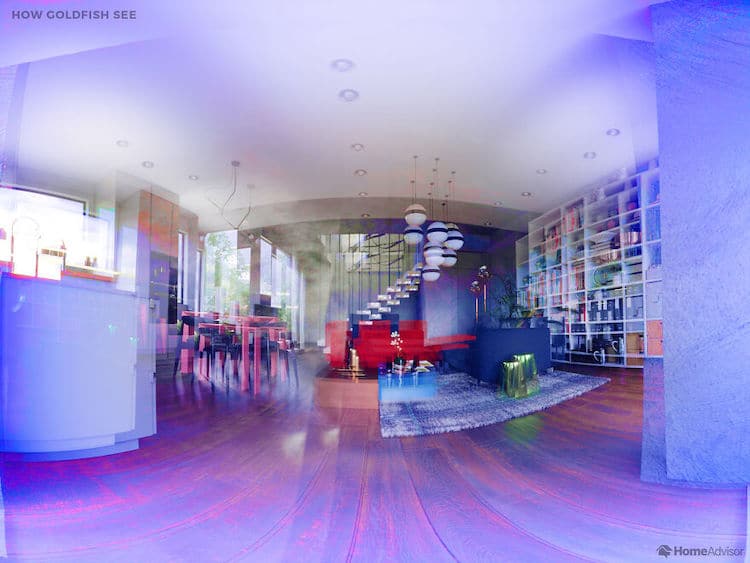
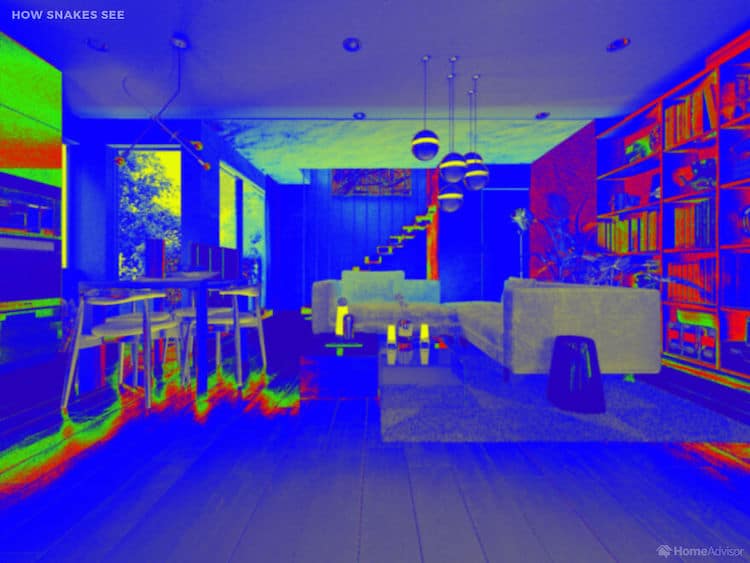
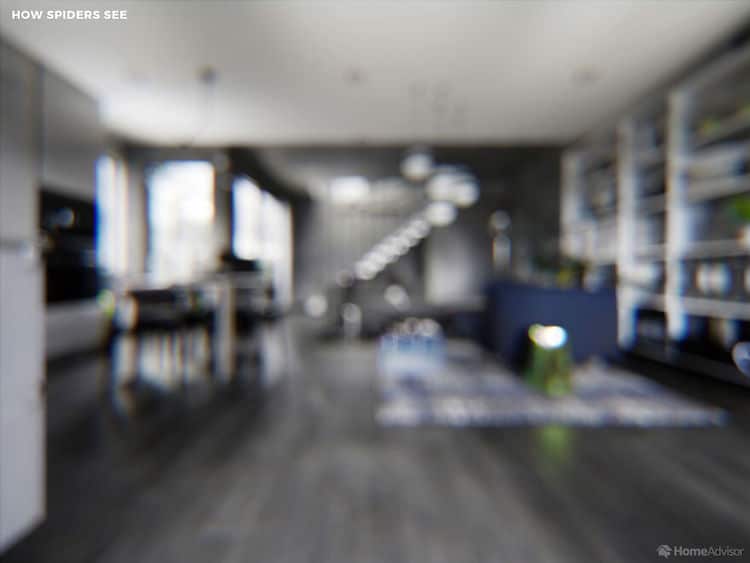
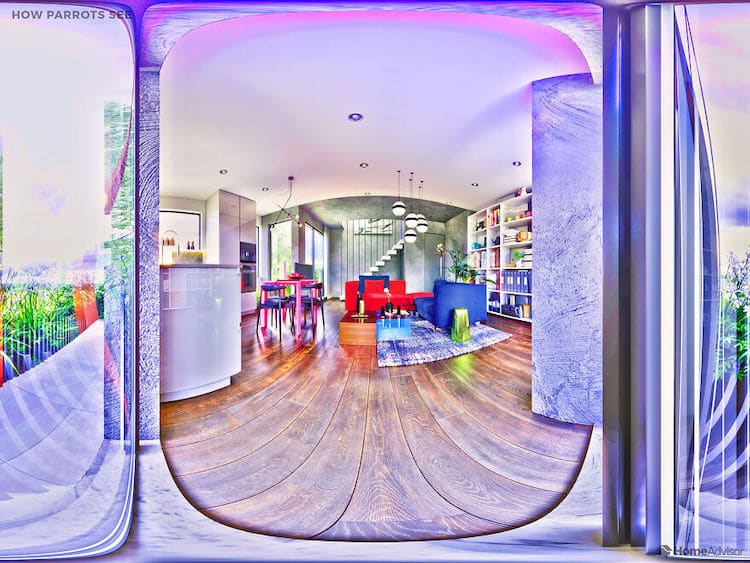

HomeAdvisor: Website | Facebook | Instagram | Twitter | YouTube
h/t: [Bored Panda]
All images via HomeAdvisor.
Related Articles:
12 Incredible X-Rays Reveal How Different Pregnant Animals Look
Funny Illustrations Reveal Delightfully Quirky Names for Different Groups of Animals
Study Finds That 4-Month-Old Ravens Are as Intelligent as Adult Apes
Study Finds That a Dog’s Heart Rate Jumps When You Say “I Love You” To Them





















































































